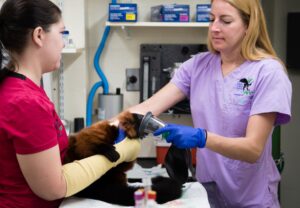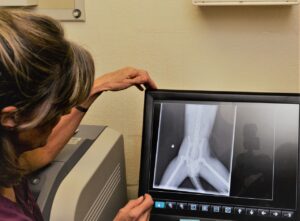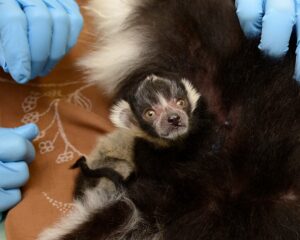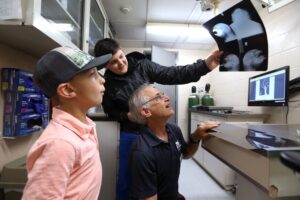Caring for Lemurs – Young and Old
The Duke Lemur Center (DLC) is responsible for providing care to over 200 lemurs every day! An important part of this responsibility is the medical care provided by the veterinary staff. The DLC veterinary team consists of two full-time veterinarians and two full-time veterinary technicians dedicated solely to providing preventative, wellness, and sick care to the world’s most diverse collection of lemurs outside their native Madagascar.

Some patients are more cooperative than others, but most lemurs at the DLC are trained to hop on the scale for weight checks!
A typical day for the vet staff starts with “rounds,” just like any hospital, checking in on any sick or injured lemurs, and discussing the best plan of care as a team. The rest of the morning may be scheduled with routine physical examinations (just like your annual check-up at your healthcare provider). The DLC veterinarians examine the lemurs from head to toe to make sure they are healthy and doing well. They monitor weight, tooth and fur condition, blood work, and overall attitude – sometimes a subtle change in behavior is an indication that a lemur is not feeling well. The DLC animal caretakers see and interact with the lemurs every day and know them best, so their feedback proves invaluable to the veterinary team’s evaluations.

DLC veterinary technicians Megan Davison and Cat Ostrowski gently restrain a red ruffed lemur going under anesthesia for a more in-depth exam.
In addition to morning rounds, a typical day may include pregnancy checks! Just like a human going in to have an ultrasound, the lemurs undergo this same non-invasive study to diagnose and monitor pregnancy. The vet team also assists the DLC research department in obtaining data, follows up with sick and injured lemurs throughout the day, and often gets advice or consultation from outside experts. Sometimes a challenging or complicated case requires the advice from a radiologist (x-ray, CT scan interpretation), ophthalmologist (eye specialist), orthopedist (bones), or a cardiologist (heart). Many of the procedures and surgeries performed on the lemurs are identical to what you or someone you know might undergo. The DLC has removed gallstones (called a cholecystectomy), repaired broken bones, sutured lacerations, and even transplanted a cornea – just to name a few.

Former DLC vet and current Animal Curator Cathy Williams examines a pelvic x-ray image of a DLC resident.
The vet team vaccinates the lemurs routinely for rabies, as many of them live in the Natural Habitat Enclosures (NHEs), and they may come in contact with raccoons, foxes, and other animals that can transmit the disease. The DLC vet team also uses Frontline® to prevent fleas and ticks, but did you know the bot fly is the number one concern and cause for applying this topical preventative? Fortunately, lemurs are exceptionally good at grooming themselves and each other with their toothcombs, so most pesky insects are not too much of a concern.

The vet team provides critical care and support for the DLC’s breeding program for new infants like this critically endangered black and white ruffed lemur.
In order to ensure that lemurs have the best possible chance to thrive and survive, the DLC participates in the Association of Zoos and Aquariums Species Survival Plans® (SSPs). The SSPs provide detailed guidance on breeding for the healthiest possible genetic safety net as a companion to in-situ conservation efforts. On average, the DLC welcomes 10-20 infants each year across 15 different species. The expertise and experience of the DLC vet team is crucial to a successful breeding program – requiring care (sometimes literally around the clock) for pregnant moms, newborn infants, adolescent lemurs, and adults who often age 5-10 years beyond the life expectancy in the wild. The oldest lemur to date lived 37 years at the DLC!

Birthdays in the 30s are nothing to sneeze at, and the vet care at the DLC helps many of the lemurs live many years past their life expectancy in the wild.
Connecting with other veterinary and medical experts is essential to providing the best possible care for the lemurs of the DLC, and the vet team pays that forward by advising other zoos and research institutions with lemurs in human care around the world. Since opening in 1966, the DLC has had over 3200 lemur births, resulting in a wealth of collective lemur care knowledge amongst the staff, particularly the veterinary team. Due in part to a lengthy and complicated digestive tract, the Coquerel’s sifaka has proven to be the most challenging species to care for, requiring special diets and close monitoring for signs of illness. Many of DLC vet team’s consults involve assisting other facilities in caring for this fascinating and delicate species.

DLC veterinarians Drs. Laura Elsaesser and Bobby Schopler inspire a potential future lemur veterinarian with x-ray images of the unique aye-aye’s skull and hand.
This open exchange of lemur care information also feeds into DLC conservation initiatives. In the past two years, donated funds allowed an animal care team member traveled to Madagascar for several months to advise Malagasy zoos, and two Malagasy veterinarians traveled to the DLC campus for an extended residency – working directly with the DLC veterinary team in order to bring a wealth of firsthand knowledge and experience back home to Madagascar.
The Duke Lemur Center is fortunate to have such a well-trained and knowledgeable veterinary team caring for this unique and irreplaceable collection of primates. Each and every day they do amazing things to help the animals remain healthy, happy, and active for many years to come.

